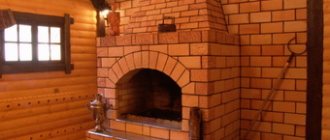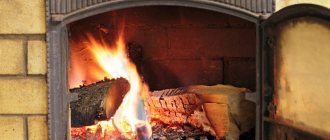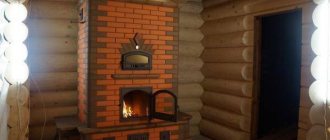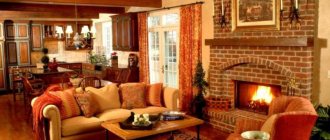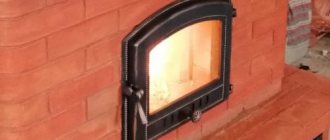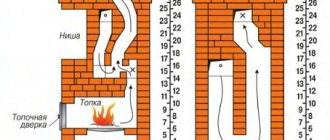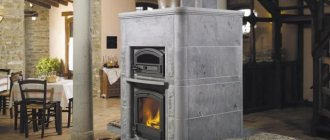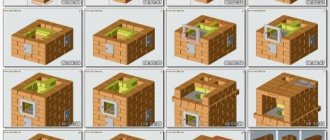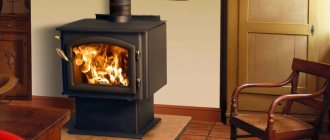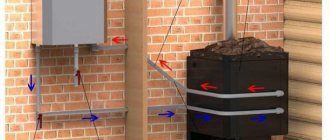The hearth is the heart of buildings not connected to centralized networks. It generates the heat necessary for life and provides energy for cooking. The microclimate in the building and its service life directly depend on its productivity and efficiency, and these are very important factors in the operation of the unit, don’t you agree?
The article we presented describes in detail how to competently build a brick stove for your home. Schemes for building a home are given, and technological nuances are thoroughly analyzed. We offer carefully selected, scrupulously verified, practice-proven information on the selection and installation of brick stoves.
Beginning stove makers and country property owners who want to supervise the work of hired craftsmen will be helped by the information we offer, based on construction requirements. Photographic images and video tutorials will be an excellent help in mastering the material.
What is the difference between a Dutch woman and a Swedish woman, I confuse them
The Dutch oven was created specifically as a heating stove, but now they are making a hob in it. This device is much simpler than a Russian stove: a combustion chamber with a labyrinth of smoke ducts on top. The smoke travels along this winding path for a long time, and thanks to this the heat does not escape. In our country, Dutch was traditionally decorated with tiles - this option is considered a classic.
The Swedish stove is an improved version of the Dutch stove with a vertical system of smoke circulation channels. Swedish scientists optimized it in the mid-18th century by expanding the lower part and adding an oven to the side.
The Swedish oven is the result of careful calculations. With its quite compact size, it warms up quickly, allowing you to cook food, heat the house, etc. The efficiency of the Swedish stove is slightly inferior to that of the Russian stove, but this design requires precise calculations. They drown the Swede twice a day.
Do-it-yourself brick oven for a home: masonry process with photos
The question of how to build a brick stove for a home with your own hands continues to be relevant today, since comfort and warmth have always remained important conditions for a person to have a good rest after a busy day at work. Therefore, recently more and more city residents are moving from panel high-rise buildings to private houses, where it is possible to create a comfortable environment at any time of the year.
Do-it-yourself brick oven for your home
Due to the demand for various models of furnaces, engineers continue to develop new options suitable for buildings with different areas. It should be noted that even when all the “blessings of civilization” are present in the house, a small cozy stove will never be superfluous and will help out in various situations. For example, it can be heated on cold spring or autumn evenings, when it is humid or raining outside, without starting the heating system. Such a structure will help create an optimal balance of temperature and humidity in the house, which will be comfortable for a person. In addition, the oven will be an excellent assistant in cooking or drying vegetables, herbs and fruits.
Since there are a large number of different models of heating structures, you should choose stoves with the most accessible, easy-to-read diagrams for DIY installation, especially if you have little or even no experience in this craft. Naturally, it is necessary to take into account other factors that directly affect the efficiency of the stove - its power, dimensional parameters, functionality, and also the aesthetic appearance is also important. And in order to choose the right stove model, you need to consider the criteria that you need to focus on when determining the desired option.
How to choose the best oven option?
Choosing a furnace installation location
In order for the furnace to be fireproof, efficient, and its power to be used to the maximum extent possible, this structure must be installed correctly, taking into account some nuances.
- Firstly, it is decided how much area can be allocated for installing the stove.
- Then, you need to decide on a specific location:
— the stove is installed in the center of the room, dividing it into separate zones;
— built into the walls, between two or three rooms;
- erected near the wall, with a distance of 250÷300 mm from it, if you need to heat only one room. However, it must be taken into account that this option is the most losing, since most of the heat generated by the rear walls will not be fully used.
Several options for placing the stove in the house
- Having chosen an approximate location, you need to immediately mark it, starting from the ceiling, using a plumb line, since the chimney pipe must pass through the attic floor between the beams and rafters, and at a distance from them of at least 120÷150 mm.
- When allocating an area for the furnace, it is taken into account that for its foundation it is necessary to provide more space than its base, by 100–150 mm on each of its sides.
- To avoid any problems with regulatory organizations, when choosing an installation location, you need to take into account not only the recommendations presented above, but also the standards developed by specialists and specified in SNiP 41-01-2003.
Calculation of the required power and assessment of firewood consumption
A furnace will not be efficient and will not be able to heat your home if it is not powerful enough for a particular area. This also takes into account the winter temperatures of the region where the heated building is located, the number of windows and doors in it, the level of insulation of walls and floors, ceiling height and many other conditions.
For example, the higher the ceiling, the larger the volume of air will have to be heated, and the larger the glass area, the faster the heat will leave the house, which means you will have to choose a stove with increased power. Typically, for buildings with non-standard glazing and other parameters that do not fall under the average statistical level, calculations must be made by a specialist individually, based on the specific characteristics of the house.
But in general, you can rely on average values. Thus, for well-insulated houses with conventional glazing, with an area of 50 to 100 m², with a ceiling height of 2.5 to 2.7 m, the following thermal power standards per unit area (Wsp) are acceptable:
| Region of Russia in which construction is taking place | The specific power of the heating system, Wsp (W/m²) |
| Southern regions of the country (North Caucasus, Caspian, Azov, Black Sea regions | 70 ÷ 90 |
| Central Black Earth Region, Southern Volga Region | 100 ÷ 120 |
| Central regions of the European part, Primorye | 120÷ 150 |
| Northern regions of the European part, Urals, Siberia | 160 ÷ 200 |
This value can be found out more accurately from your local construction organization. And for those who like to do their own calculations, we can recommend a more detailed and fairly accurate algorithm.
How to accurately calculate the required thermal power?
Each room is unique in its own way, and heating two seemingly equal rooms may require different amounts of thermal energy. The methodology for calculating the power of heating equipment is set out in a special publication on our portal dedicated to the selection of heating boilers .
Having data for a specific region and the size of the heated area (S), the furnace power for it is calculated using the formula:
Wsum = S (m²) × Wsp (kW/m²)
For example, we can consider the power of a furnace for a brick house located in the central part of Russia and having an area of 75 m² .
Wsum = 75 × 0.14 = 10.5 kW
Typically, stove developers immediately indicate the thermal power of their designs. True, other units of measurement are often found - kilocalories per hour or megajoules. It’s not scary - they can be easily converted into watts and kilowatts:
| W | kcal | MJ | |
| 1 W | 1 | 0.859845227859 ≈ 0,86 | 0,036 |
| 1 kcal | 1.163 | 1 | 0,042 |
| 1 MJ | 277.77 | 238.85 | 1 |
In our case, for example, the calculated power in kilocalories will be equal to:
10500 × 0.86 = 9030 kcal/hour
Now you can calculate the efficiency of the future stove, which largely depends on the quality and type of wood used as fuel. At the same time, we must not forget that usually brick wood-burning stoves are not characterized by high efficiency. It is usually estimated at around 70%. If there is data for a specific oven model, then a specific value is substituted.
Each type of solid fuel has its own calorific value - the amount of thermal energy that is released when burning 1 kilogram. It is clear that only bulk fuels - coal or briquettes - are usually measured in kilograms and tons, and firewood is usually measured in storage cubic meters. This indicator thus depends on the specific density of a particular type of wood. Indicators of the energy potential (based on mass and storage volume) of the main types of solid fuel are shown in the table.
| Wood type | Average calorific value of dry firewood by mass, Qm (kW/kg) | Average calorific value of dry firewood by storage volume, Qv (kW/m³) (for coal and briquettes - kW/t) | The same applies to damp wood (which has not undergone at least a one-year drying cycle) |
| Firewood: | |||
| Beech | 4.2 | 2200 | 1930 |
| Oak | 4.2 | 2100 | 1850 |
| Ash | 4.2 | 2100 | 1850 |
| Rowan | 4.2 | 2100 | 1850 |
| Birch | 4.3 | 1900 | 1670 |
| Elm | 4.1 | 1900 | 1670 |
| Maple | 4.1 | 1900 | 1670 |
| Aspen | 4.1 | 1750 | 1400 |
| Alder | 4.1 | 1500 | 1300 |
| Willow (willow) | 4.1 | 1400 | 1230 |
| Poplar | 4.1 | 1400 | 1230 |
| Pine | 4.4 | 1700 | 1500 |
| Larch | 4.4 | 1700 | 1500 |
| Fir | 4.4 | 1600 | 1400 |
| Spruce | 4.3 | 1400 | 1200 |
| Coal and briquettes: | |||
| Anthracite | 8.1 | 8100 | — |
| Charcoal | 8.6 | 8600 | — |
| Coal | 6.2 | 6200 | — |
| Brown coal | 4.2 | 4200 | — |
| Fuel briquettes | 5.6 | 5600 | — |
| Peat briquettes | 3.4 | 3400 | — |
The calorific value of undried firewood is shown for contrast - how much generated power is lost. Naturally, you should still rely on firewood that has gone through the necessary drying cycle.
Preparing firewood is a serious matter!
In order for the stove to live up to its purpose and serve as long as possible, it should be “fed” with the right fuel. About which firewood is better , about its main characteristics, rules for harvesting, drying and storage - in a special publication on our portal.
The average daily weight consumption of fuel to ensure the necessary heat transfer is determined by the formula:
V(kg)= (Wsum / Qm) × 24 hours
To calculate the volume, everything is the same, but instead of the calorific value by mass Qm, Qv is substituted .
Knowing the daily consumption, it is easy to determine the weekly, monthly and even for the entire expected heating period - in order to have an idea of the upcoming costs of purchasing or procuring the required amount of firewood.
To facilitate independent calculations, below is a convenient calculator, which already contains the necessary ratios. The calculation is carried out for dried wood.
Calculator for calculating the estimated consumption of solid fuel
Go to calculations
Don’t be afraid of too high values - consumption can be significantly lower, since it is designed for the most unfavorable conditions. In fact, on fine, windless days or during thaw periods, significantly less fuel will be consumed. But you need to be ready for anything!
Types of brick wood stoves
Of course, you also need to decide on the type of stove - this criterion is selected depending on what the home owners would like to get from the structure being built, that is, on the desired functionality.
Heating brick stoves for the home are divided into the following types:
- Multifunctional heating and cooking stoves can be called the most popular. Depending on the capabilities implemented in the design, such stoves are used for heating a house, cooking, baking bread, heating water, drying fruits, vegetables and medicinal herbs.
Multifunctional heating and cooking stove
Designs have been developed equipped with a bed, which can easily serve as an additional heated sleeping place.
Heating and cooking models are usually built into the wall between the kitchen and living space. Thus, two problems are solved at once - heating two rooms and providing cooking.
- Stoves intended only for heating are not chosen so often. A pure heating model is often equipped with a water circuit, to which the water heating of the house is connected. Since this structure has a single function, aimed only at heating, they usually try to install it between two, three or even four rooms. The size and power of the structure are selected based on how many rooms are planned to be heated with one stove.
A typical example of a heating stove
It must be said that this version of the stove, if equipped with a large combustion door with transparent glass, can also be used as a real fireplace, since its design allows you to enjoy the play of fire through the glass or open doors of the firebox.
- Cooking stoves are usually compact in size and consist of a cooking section, which includes a stove and oven, and a chimney. One way or another, such a structure gives off heat to one or two rooms, depending on the location, but such a stove is not capable of heating a large area. Most often, such models are installed in small country houses used in the warm season, when even such a compact stove is quite sufficient for heating on cool days or nights.
The main purpose of such a stove is cooking.
The advantage of such models is its simple design, the diagram of which can be understood even by a beginner in the stove craft.
It should be noted that this small stove will not be superfluous not only at the dacha, but also in an ordinary private house, even if it has a gas supply.
Having decided on a stove model that will meet all the necessary parameters, you need to choose the right material for its construction.
Basics of masonry stove construction
Basic materials for laying the furnace
In order for the stove to have a respectable appearance and last as long as possible, you should purchase high-quality material for its construction, and it is unwise to save on this. The main materials are brick and mortar.
- For the main masonry you will need red solid brick. Its quantity is always indicated in the design of a specific furnace model. If finishing with any decorative materials is not intended, then it is necessary to purchase bricks with perfectly even shapes without chips on the edges.
High-quality red brick
For laying surfaces in contact with open fire, fire-resistant fireclay bricks are used, which can withstand temperatures reaching up to 1500 degrees. When heated, this material retains a high temperature for a long time, and thanks to this quality, the oven remains hot for a long time.
Heat-resistant fireclay brick
- It is equally important to choose the right mortar for laying bricks, since the strength, durability, and safety of the stove building depend on it. The traditional method for constructing stoves is clay mortar, which is often made independently.
Ready-made stove mortar in the form of a dry mixture can be purchased in a store.
Nowadays, in specialized stores you can find ready-made dry mixtures intended for the construction of heating structures. This composition contains all the necessary ingredients in the right proportions, and therefore the mixture is easy to use. However, the price of such compositions is quite high, and in order to save money, many craftsmen prefer to extract and purify the necessary components for the solution themselves.
The main ingredient of heat-resistant masonry mortar is clay.
How to find, select and prepare clay for laying stoves , and then make a high-quality solution, is described in detail in a special publication on our portal.
Foundation for the stove
A few words need to be said about the basis for the structure of the furnace, since the reliability and durability of the structure primarily depends on it.
The foundation can be made of different materials and according to different schemes, but in any case, its construction requires a pit that goes deep into the ground by at least 500 mm.
The second condition that must be met is that the base for the stove should never be combined with the foundation of the house.
The stove foundation can be a reinforced concrete structure, which is formed using formwork and reinforcement lattice, and then filled with concrete mortar.
Diagram of one of the furnace foundation options
Another base option consists of concrete, rubble stone and brick. By equipping this foundation, you can save on concrete mortar, since it will be required much less than in the first option. This base consists of the following layers:
1 – In a dug pit, waterproofing is installed on the bottom and walls - a clay castle. The clay layer should be 50÷70 mm.
2 – A sand cushion is poured onto the clay base and compacted well. Its compacted thickness must be at least 100 mm.
3 – The next layer is rubble concrete. To do this, rubble stone is laid in layers on a sand bed, which is poured with concrete mortar. It is very important to ensure that all cavities between the stones are filled with mortar. This way the entire pit is filled to the top.
The foundation must be raised above the ground surface by 150÷200 mm. To do this, formwork made of boards is installed along the edge of the pit. Then, a stone is placed in it and, in the same way, it is filled to the top with concrete, which is leveled using the rule and left to harden. The process of hardening and gaining brand strength is quite long and will take about 20–28 days, depending on the ambient temperature.
4 – After the foundation hardens, a waterproofing material is laid on top of it - roofing felt in two or three layers.
5 – The next stage is masonry from any type of brick or stone - from them walls are raised that are 80÷100 mm smaller than the perimeter of the poured foundation. The size of this part of the base should be equal to the base of the oven.
The internal space between the walls is filled layer by layer with rubble stone, and each layer is also poured with concrete mortar. This process is carried out until the brick formwork is filled to the very top. Then the surface of the solution is leveled and left to dry.
Two more layers of roofing material are laid on top of the finished foundation.
6 – It is recommended to lay the next layer 4÷5 mm thick with felt soaked in a clay solution, which will ensure a tight fit of the first row of the stove masonry to the base.
The foundation is left for 7-10 days to dry and shrink, and only then the furnace is laid.
Pre-laying the oven dry
It is recommended to lay the entire structure of the furnace dry, that is, without mortar, in order to understand the specifics of installing the bricks of each row and gain at least minimal experience in this work, especially if it is being carried out for the first time.
When building a stove without mortar, you need to take into account the thickness of the vertical joints and strictly follow the order. To maintain the thickness of horizontal seams, plastic or wooden calibration strips with a thickness of 5–6 mm are often used.
When making dry masonry, you need to immediately understand the configuration of the internal channels through which combustion products will be directed into the chimney. If a mistake is made in their location, you will have to disassemble the entire folded structure, since there will be no proper draft and smoke will enter the premises.
Having erected the entire furnace dry up to the chimney, the structure is dismantled. If desired, each of the rows can be numbered and stacked in separate piles, immediately adjusting the individual bricks to size and shape.
Such preparatory work will significantly speed up the process of laying the mortar, and in order not to waste time, it can be done during the period when the foundation is gaining strength.
Installation of cast iron stove elements
One cannot fail to mention the correct installation of cast iron stove elements. It is especially important to properly install parts that will come into contact with an open fire - this is the combustion door, hob and sometimes the oven.
Read the review of models of wood-burning cast iron stoves for summer cottages, as well as the characteristics and advantages, from our new article.
As you know, when heated, metal expands significantly, so for cast iron elements it is necessary to provide a seat size 5 mm larger than the size of the part itself in each direction.
Before installing the hob, asbestos strips are laid at the place where it is laid, which will create the necessary conditions for its operation.
Heat-resistant gasket under the hob
Before installation, the furnace door is wrapped around the contour with an asbestos cord, which will also create a thermal gap for the expansion of the metal when it is heated. In order to protect the steel box of an oven or hot water tank from burning, it is also wrapped with asbestos cord.
Installation of doors and metal chambers
The doors are fastened using annealed steel wire, which is fixed to special “ears” located on the back of the door frame, and the ends are embedded in the seam between the bricks. Temporarily, until the door is fixed with masonry, it is supported with stacks of bricks for stability.
Project of a multifunctional two-bell furnace with ordering
General characteristics of the model
This project, available for implementation, is perfect for installation in a small house. The design of this stove is quite simple and is equipped with several functions, such as a hob and a drying chamber, instead of which it is quite possible to install a water heating tank. Those who decide to install a stove in their home are most often interested in compact, multifunctional designs that can heat as many rooms as possible.
If we compile a list of requirements for furnaces in modern conditions, the following criteria come to the fore:
- The stove must have several functions, that is, it must work not only to heat the house, but also have a hob.
- Compact structure is one of the main requirements for stoves installed today in small private houses. This is especially true for buildings on summer cottages. Therefore, the optimal oven size is 4.5 × 3.5 bricks.
- The heated area for which the structure is designed must be no less than 30 square meters. m.
- Basically, all owners like stoves with arched elements, as they have the most aesthetic and comfortable appearance.
- Simplicity of design is also important, especially for those who are doing this work for the first time.
- The presence of summer and winter operating modes is necessary so that you can economically use the oven for cooking during the warm season.
- It is desirable to have a drying chamber or hot water tank.
- The depth of the combustion chamber should be at least 500 mm, as this is the optimal length of firewood logs.
The presented furnace design meets all the listed requirements, and is based on the design of a two-bell furnace operating on the principle of free circulation of gases.
Diagram of gas movement in a two-bell furnace
This heating and cooking two-bell stove has dimensions of 1140×890 mm, with a height of 2024 mm, and has a heat output of at least 3800÷4000 kcal/hour - suitable for heating an area of 30÷35 m². The efficiency of such a two-bell design reaches 75 ÷ 80%, which is a very good indicator for brick kilns.
The depth of the combustion chamber of this stove model is 600 mm. It has walls lined with fireclay refractory bricks installed on a “spoon”. The heating structure is equipped with a standard size two-burner hob installed in a cooking chamber with an arched ceiling.
It is the arch that gives the stove an aesthetically pleasing appearance, although it somewhat complicates the work of the master
There is a drying chamber above the arched opening, instead of which some craftsmen prefer to install a water heating tank. An oven is not suitable for installation in this area of the oven, as it will not heat up properly.
It should be noted right away that if someone finds the masonry of the arched structure difficult, then it can be completely replaced with a flat horizontal ceiling of the cooking chamber. To do this you will need to cover it with metal strips and corners.
The stove design has a direct “summer” stroke, which allows it to be used in cooking mode without fully heating the stove, and, accordingly, the entire room, which is very convenient in the summer. In addition, the “summer” valve, depending on its position, increases or decreases the intensity of fuel combustion.
The advantage of this design is its uniform heating, which is very important for the durability and quality of the stove. All ceilings in the oven, except for the cooking chamber, are made without the use of metal elements.
Left-hand and right-hand oven options
The stove is presented in two versions with different locations of the chimney, respectively, and a mirror design, so you can choose from them the one that is more suitable for the specific layout of the house.
Sections of the furnace must be studied in order to have an idea of the configuration of the channels and the location of the hoods in this design
Find out how to build a Russian stove with your own hands with detailed instructions and video instructions from our new article.
Necessary materials
To obtain the desired result, both aesthetically and in terms of the efficiency of the structure, it is recommended to use high-quality bricks with rounded corners for the construction of some elements of the furnace. If for some reason it is not possible to purchase such material, then the corner brick can be processed independently.
So, to build this furnace, excluding masonry mortar, you will need the following materials:
| Name of materials and elements | Amount | Dimensions of elements, mm |
| Red brick M-200 (excluding pipe laying) | 722-725 | 120×250×65 |
| - of which with rounded corners (curly) | 172 | — |
| Fire-resistant fireclay brick, grade Ш-8 | 26-28 | 120×250×65 |
| Fire door | 1 | 210×250 |
| Doors for cleaning channels | 4 | 140×140 |
| Blower door | 1 | 140×250 |
| Summer damper for chimney | 1 | 130×250 |
| Fire valve | 1 | 130×250 |
| Stove valve | 1 | 130×130 |
| Grate | 1 | 250×300 |
| Single burner hob | 1 | 410×710 |
| Steel corner | 2 | 5×50×50×750 |
| Pre-furnace sheet | 1 | 500×700 |
Order and description of masonry work
| Illustration | Brief description of the operation performed |
| The first row is 31½ red bricks. The row is laid out continuous, and it must be perfectly even, as it sets the direction for further laying of the furnace walls. | |
| The second row is 31½ red bricks. This row is also continuous and is laid out in a dressing with the first row. | |
| The third row is 31½ red bricks. This row is also continuous, and the configuration of its masonry is identical to the first row. | |
| Fourth row - 22 red bricks. On this row, the blower chamber and the base of the lower hood begin to form. | |
| The fourth row is a continuation. On the same row, one ash door (140×250 mm) and two cleaning doors (140×140 mm) are installed. | |
| Fifth row - 22½ red bricks. The row is laid out according to the indicated pattern. | |
| Sixth row - 24½ red bricks. On this row, two bricks located above the ash chamber are cut diagonally from above - this is necessary to cover the front part of the ash chamber and its door. In the drawing, the brick sections are shown in orange. | |
| The sixth row is a continuation. Two bricks are laid, cut diagonally on the lower right side. These bricks completely cover the upper part of the ash chamber and its door. | |
| Seventh row - 19 red and 5½ fireclay bricks. The bottom of the combustion chamber is lined with fireclay bricks. Between the red and fireclay bricks, a layer of corrugated cardboard is made, 4–6 mm thick; the height of this material should be equal to the height of the entire fuel chamber. The cardboard burns out during the initial firing of the kiln, and a thermal gap remains between the bricks, which is necessary for the expansion of the fireclay brick when it is heated. After this, a cast iron grate measuring 250x300 mm is installed. The gap between this element and the fireclay brick should be at least 5 mm along its entire perimeter, also for thermal expansion. Two bricks from the back and front sides of the grate are cut obliquely, forming a ramp for combustion products and more intense combustion of fuel. A vertical channel is being formed, which will serve as an exit for smoke from the lower hood to the upper one. | |
| Eighth row - 15 red and 7 fireclay bricks. Fireclay bricks along the edges of the combustion chamber are installed on a spoon (rib). | |
| The eighth row is a continuation. A combustion door measuring 210×250 mm is installed on the same row. | |
| Ninth row - 18½ red bricks. The row is laid out completely according to the indicated pattern. | |
| Tenth row - 18 red and 7 fireclay bricks. The fireclay brick of this row around the fuel chamber is also installed on the edge. | |
| 11th row – 19½ red bricks. In this row, the fuel chamber door begins to close. For this purpose, two bricks are used, cut diagonally from the top - they are laid on both sides of the fire door. In the drawing, the sections are shown in orange. Previously laid fireclay bricks are crossed out with a diagonal stripe. For the passage of smoke in the fuel chamber, a passage leading to the lower hood is left. | |
| 11th row – continuation. The fuel door is closed with a brick cut from the bottom on both sides. | |
| 12th row – 19 red and 6 fireclay bricks. The row is laid out according to the diagram. The walls of the fuel chamber are lined with fireclay bricks installed on a spoon. A passage is left in the wall into the lower cap. | |
| 13th row – 22 red bricks. On this row, the formation of the cooking chamber takes place. The bricks that line the entrance to the cooking chamber are moved forward by 40 mm. Above the fuel chamber along its entire perimeter, a cutout or seat is made in the red bricks for mounting the hob. There must be a gap of 5 mm between the stove and the brick, intended for thermal expansion of the cast iron panel when it is heated. | |
| Row 13 – continuation. On the same row, along the entire perimeter of the area for the hob, asbestos cord or strips impregnated with clay mortar are placed in the cutouts, on which the hob will be mounted. | |
| 14th row – 19 red bricks. The walls of the cooking chamber are being formed. Their bricks will be placed on the hob and between them you need to create a gap of 5 mm by laying strips of asbestos. To prepare for blocking the exit from the fuel chamber, the brick is cut diagonally on one side from above. In the drawing, the slice is shown in orange. | |
| Row 14 – continuation. A brick cut from the bottom blocks the passage from the fuel chamber to the hood located on the left rear side of the hob. | |
| 15th row – 18 red bricks. The walls of the cooking chamber and vertical channels continue to rise. The work is carried out according to the presented scheme. | |
| 16th row – 18½ red bricks. The masonry is carried out in accordance with the order. | |
| 17th row - 16½ red bricks. First, this row is also laid out according to the diagram shown. | |
| 17th row - continuation. You will need 16 red bricks. Next, on the same row, an arched ceiling of the entrance to the cooking chamber is formed. In order to carry out this work accurately, a template is made from plywood with the dimensions indicated in the schematic drawing (radius - 259 mm). The bricks for the arch are cut into a truncated pyramid, the lower part of which should be 44 mm. Arched bricks are installed on edge and move forward relative to the oven walls by 40 mm, just like the bricks in the lower part of the cooking chamber on the 13th row. It should be noted that you don’t have to cut the bricks into a pyramid, but in this case, the seams between them may turn out to be too wide, uneven and sloppy. After the solution has hardened, the template is removed from under the arch. | |
| 18th row – 21½ red bricks. At this stage, the lower cap is closed (only the vertical channel is not closed) and an outlet is formed from the upper part of the lower cap. Along the perimeter of the exit hole, a seat is cut out in the bricks for installing a “summer” direct stroke valve. On the bricks adjacent to the arch, cuts are made diagonally from below so that they fit tightly together and create an even masonry seam. | |
| Row 18 – continuation. Next, a valve measuring 130x250 mm is installed on the same row. Its frame is placed on a clay mortar, while preventing the mortar from accidentally getting into the guide grooves. | |
| 19th row – 15 red bricks. At this stage, the base of the upper furnace hood is formed. The bricks laid along the arch are also trimmed - this procedure is carried out in each row until the arch is completely covered. | |
| 20th row – 16 red bricks. On this row, two sections of the masonry are left open - they are intended for installing cleaning doors at the base of the upper cap of the structure. | |
| Row 20 – continuation. Next, two cleaning doors measuring 140x140 mm are mounted on the same row. | |
| 21st row – 16½ red bricks. The work is carried out according to the presented scheme. | |
| 22nd row – 19 red bricks. On this row, the cleaning doors are blocked with bricks. The covering of the arch is completed - the bricks for this are hewn from below. | |
| Row 22 – continuation. On the same row, in the middle of the space above the cooking chamber, two metal corners measuring 50x50x750 mm are installed - they are pressed against each other with their back walls. They will become the basis for laying the next row of bricks. | |
| 23rd row – 27 red bricks. At this stage, the cooking chamber is closed. Only a hole is left for arranging the exhaust from the chamber. A vertical channel is formed above the “summer” valve. | |
| 24th row – 20½ red bricks. The walls of the drying chamber are formed. The brick adjacent to the exhaust duct is cut from above at an angle of 45 degrees (the cut is shown in orange in the drawing). | |
| 25th row – 20 red bricks. In this row, the brick adjacent to the exhaust duct is cut from above at an angle of 45 degrees and becomes a continuation of the slope of the brick of the previous row. | |
| 26th row – 20 red bricks. The slope of the exhaust hole must be continued, so the brick is also cut at an angle of 45 degrees. The rest of the masonry is done according to the scheme. | |
| 27th row – 20 red bricks. Above the exhaust and vertical ducts, along the entire perimeter, cutouts are made in the bricks to create a seat for mounting the exhaust valves from the cooking chamber and chimney - 130x130 and 130x250 mm. | |
| Row 27 – continuation. Valves are installed - their frames are mounted on a layer of clay mortar. | |
| 28th row – 21 red bricks. The opening of the exhaust duct moves towards the main chimney - for this, the brick installed in the front part of the hood is cut obliquely from below, and the rear brick is cut from above. That is, a passage is formed, located at an angle. | |
| 29th row – 20 red bricks. At this stage, the exhaust duct and chimney are combined. The brick adjacent to the exhaust duct is cut diagonally at an angle of 45 degrees from below. | |
| 30th row – 34 red bricks. The upper hood of the furnace is covered. The bricks are laid with an outward shift, relative to the main masonry, by 40 mm. The brick laid on the brick cut in the previous row is also cut at an angle of 45 degrees, forming a passage on a slope. Two bricks, laid on both sides of the entrance to the drying chamber, are cut at an angle from above and form a place for the middle brick, which will complete the covering of the entrance. | |
| Row 30 – continuation. A middle brick, pre-cut from both sides from below, is installed to cover the drying chamber. | |
| Row 31 – 32½ red bricks. The masonry of this row moves inward by 40 mm, and the perimeter of this row is equal to the main size of the stove. The bricks laid on the sides of the drying chamber are cut diagonally from the top. In this way, the basis for covering the space is prepared. | |
| Row 31 – continuation. Next, three bricks are prepared, on which cuts are made from below on both sides, as shown in the drawing. Then, these bricks cover the drying chamber. | |
| 32nd row – 23 red bricks. This row covers the area of the stove near the chimney duct with another layer. On the front side of the kiln, the bricks of the row are moved inward by 80 mm, and on the left side - by 1⅓ bricks. | |
| 33rd row – 5 red bricks. The chimney pipe channel is laid. | |
| 34th row - 5 red bricks are placed in a bandage to the previous row. This row becomes the basis for further laying of the mounted chimney pipe. |
The work of a stove maker these days is not cheap. So, after carefully studying the project and the order of masonry, you can try to carry out this process yourself. In addition to the fact that a decent amount will be saved, a certain skill in the stove business will appear, which will not be superfluous for any owner of a private home.
At the end of the publication, there is a video lesson from a professional with tips on how to properly lay a brick oven:
Video: laying a two-bell furnace - part 1.
Video: laying a two-bell furnace - part 2.
Can a fireplace be installed in any room of the house or are there restrictions?
There are a lot of restrictions. It is not allowed on the second floor (usually the ceilings are not designed to support the weight of even a small fireplace), in a regularly shaped room with an area of at least 20 square meters with three-meter ceilings, so that the volume of air is sufficient for normal combustion. But a fireplace that is too small will not be able to heat a large room. For masonry fireplaces there is a rule:
area of the combustion window = 1/50 of the area of the room.
The firebox window should “look” into the middle of the room.
Heating stove diagrams
Before choosing, you should familiarize yourself with the design options for each design.
Diagram of a heating furnace Construction of a cooking furnace Construction of a heating and cooking furnace
You immediately need to think about the installation system. After all, each design has its own requirements. Heavy ones will require a large foundation. For cooktops, you can get by with a small stovetop.
4a21b1eb90fc532b5417af3d3fc20fc3.jpe
Preparatory work
First you need to decide on the location of the future furnace. The first time a stove is erected is when housing is being built, which means that the shape and dimensions of the stove have already been determined, as well as its location.
Photo of the foundation diagram for the furnace
- The location of the stove largely depends on the layout of the entire building, and its location should be such that it effectively heats the entire living space.
- If the location is determined, you can begin building the foundation. Its dimensions should be slightly larger than the geometric dimensions of the furnace. During its construction it is necessary to install waterproofing.
- When carrying out masonry, you should remember that the seams should be minimal and the evenness should be maximum.
- When laying out the internal surfaces of chimneys, there should be no sagging of mortar, and the surfaces should be smooth. It is advisable to remove excess mortar released from the seams. Both the side surfaces and the corners must be laid out carefully.
Attention: The foundation must support the weight of the structure. Therefore, it will need to be reinforced. This will add additional rigidity.
I made a foundation for the fireplace stove, tied to the main tape. Am I right?
No. The stove, like a cat, loves to walk on its own, and the foundations for heating structures must be autonomous. This will protect the foundation from frozen groundwater, movement and any lateral loads.
Exceptions are made in two cases:
- quicksand soil;
- piles.
In the case of an abutment, a soft insert is installed between the furnace foundation and the tape. But not a wooden shield, for example, or sand. The simplest soft insert around the perimeter of the foundation under the stove can be made from a foam plastic board 5 cm thick.
If you nevertheless decide to make a common foundation for the house and the stove, you need to take into account the uneven load and install additional reinforcement in the concrete monolith between the main perimeter and the platform along the foundation of the stove.
Brickwork algorithm
The stove is laid out on a concrete base.
The construction of the stove takes place on a finished base, which protrudes beyond its limits by 10-20 cm. On the side of the firebox, experts recommend leaving 50-70 cm for installing the pre-furnace platform. The construction of the structure is carried out using clay-sand mortar according to the prepared drawings.
Make the first two rows continuous masonry. On the third - start laying out the chamber for the blower by installing the door on the wire. The fourth level involves further laying bricks, strengthening the ash pit and equipping a ledge for the grate. Install the grille itself without mortar on the fifth row, leaving gaps of 5-7 mm.
Having reached the sixth row, install the combustion door in the portal. Secure it with steel wire or slats to the mortar. From levels 7 to 11, continue laying out the firebox.
Metal tape for fixing masonry
After completion of 11 p.m. lay a metal strip or corner to support the hob. Then install the decking for the panel. From rows 12 to 15, begin building walls around the chamber and a chimney coming from the firebox. To construct the fireproof vault, use a sheet of flat slate. At 16 r. cover the cooking vault with solid brickwork and continue to form a smoke outlet. When finished with the work, install the chimney door to clear soot and debris - use a steel plate. Secure the element with mortar. From rows 19 to 22, lay the bricks according to the pattern.
Lay out the niche for the oven from the 23rd row, on the next one - fold the walls and install the cabinet. At the bottom of the chamber, place strips of asbestos cardboard around the perimeter of the niche. Wrap a rope made of the same material around the oven. These works are aimed at strengthening contact with the brick and better heat accumulation. Finish the closet arrangement.
Starting from rows 25 to 27, lay the laying around the oven. At the next level, install a second door for the outdoor smoke duct. At 29, continue the laying and make the first valve, install the second on the 32nd row, which is also the basis for a brick or metal pipe. From 30 to 35 - continue construction of the furnace according to the project.
After completing the work, dry the stove and test fire it. This event is best carried out with a fire service specialist to draw up a report on the safety of the structure.
Isn't a stove dangerous? A spark falls from the tank, or the wall overheats - and that’s it, there’s a fire!
For safety, fire safety cuts and retreats have long been calculated. Setback is the safe distance of the stove from the wall (the wall must be protected from overheating and fire, and the distance can be either closed or open).
Cutting is performed at the intersection of combustible house structures with a stove or chimney and represents a completely non-combustible space.
You can read more about fire protection using the link at the end of the article.
Possible problems
Water circuit for heating
Small-sized brick stoves for the home are recommended to be built in a small building or temporary shed. For example, such buildings with a heating structure can be built next to the main cottage. Such a structure is ideal for supplying heat to a small area to which it is impractical to supply central heating, including a workshop.
Before starting construction, you should familiarize yourself with common mistakes:
- Brickwork is carried out without tying the seam to seam.
- The use of metal plates or elements in areas of contact with fire.
- The location of the brick in the pipe on the edge.
- Cladding without taking into account the degree of expansion of materials.
- Incorrect insulation of lumber.
- Incorrect placement of the oven on the base.
A small brick building for heating is relevant in the country house, house and garage. Depending on the purpose, the size and location for installation are selected.
Principles of laying bricks
All voids must be filled with mortar: horizontal joints - no more than 5 mm in width, vertical joints - no more than 3 mm in width. The laying must be carried out strictly according to the scheme and pre-selected without mortar. The door is fixed with steel wire.
Steel parts have different abilities to conduct heat, so they need to be laid at a distance that is filled with asbestos. A solution of clay and sand is prepared in advance in proportions of 1 to 1.5.
When choosing bricks, it is especially important to pay attention to its quality. It is not recommended to use insufficiently fired bricks or materials with cracks. This rule applies to the installation of any stove, be it a wood-burning stove for a summer cottage or a stove for a home.
Cleaning and restoration
If used frequently, the oven will need to be cleaned approximately once a month because the oven will gradually fill with ash.
If smoke breaks into the room, you need to find all the places where the seams are of poor quality and seal them with cement and liquid glass. Although most often a stove made by a professional has a long service life.
Buslaevskaya stove: projects
The design has a built-in hood. The oven is small in size. It is ideal for any private home, as it allows you not only to heat the premises, but also to cook food. Despite its compact size, the stove heats spacious rooms well, which is why there are ready-made designs for houses with a stove.
Special schemes for laying brick stoves will help you complete the work without carrying out complex calculations.
For installation you will need the following materials:
- doors - firebox (0.2x0.25 meters), VK (0.39x0.5 meters), blower (0.14x0.14 meters);
- refractory - 43 pieces;
- solid brick – 382 pieces;
- oven-cabinet 28x33x50 centimeters;
- cast iron stove 0.7x0.4 meters with burners (removable rings of different diameters);
- valves - steam exhaust (12x13 centimeters) and smoke (12x25 centimeters);
- grate - grate 30x20 centimeters;
- corner - three equal-flange blanks 1 meter long and 45x45 millimeters in size;
- steel - piece 0.3x0.28 meters;
- strip - 4 pieces of meter (4 graph paper), 0.25 meters (2 graph paper), 0.35 meters (3 graph paper);
- cast iron plate – 0.4 x 0.25 meters; 40x15 centimeters.
Projects for brick stoves of this type look like this:
- Full row.
- Blower door.
- Window opening for cleaning.
- The bottom of the oven is lined with refractory, three sides are lined with iron.
- Installation of the combustion door, grate, refractory under the firebox, cleaning cover, ash door.
- Installation of DS.
- Laying refractory on the edge around the door.
- Laying according to the scheme.
- The oven is top coated with clay (1 centimeter), the heater is covered, and a stove with burners is attached.
- Installation of smoke circulation with cleaning windows, the stove is not laid. Subsequently, the brick is placed on its edge.
- The cleaning is overlapped, channels are created, and 25-centimeter strips are laid.
- The cleaning is completed and the fastening wire is installed.
- The cap is installed.
- Installation of the VK ceiling, while the hoods remain.
- The stoves are laid out according to the diagram.
- The small stove ends in sheet iron, the masonry is done in the same order as a brick stove.
- The cleaning hole of a large stove is laid out, the edges of the side walls of the channels are cramped.
- Laying protrusions.
- The projections are duplicated and the corner is installed.
- The BP chimney is closed in the same way as row 19.
- A three-row neck is made, the size of the chimney is reduced to a section of 26x13 centimeters for the top valve.
- A chimney is created with grooves on this and subsequent rows.
The dimensions of the structure increase when using clinker facing bricks, so using them instead of solid material is not recommended. When finishing with tiles, durability is ensured (the material lasts for decades), in addition, it can be dismantled for cladding other heating structures.
Using drawings
In order to avoid significant mistakes when installing a long-burning wood stove, it is necessary to use drawings.
It is not advisable for beginners to draw up drawings on their own, as this can lead to irreversible consequences.
- There are several types of masonry, but the main stages are repeated almost everywhere.
- It is recommended for both beginners and experienced layers to first lay out the layout without mortar in order to accurately follow the diagram and take into account all the nuances.
- This is necessary for proper installation of the chimney, and, therefore, for proper draft.
Laying the foundation
Before installing a wood-burning stove-fireplace, you need to take care of laying out the foundation. There are cases when there is no need to install a foundation and install the stove directly on the ceiling, but in this case, it is necessary to take into account the load on the ceiling.
For the foundation can be used:
- Solid brick.
- Reinforced concrete slab.
- Solid concrete.
It is extremely undesirable to lay on sand-lime brick, as it is destroyed in a damp environment.
How deep the foundation will be laid depends on the natural qualities of the soil. It is advisable to lay it below freezing point. A cushion of sand and gravel is laid under the foundation.

